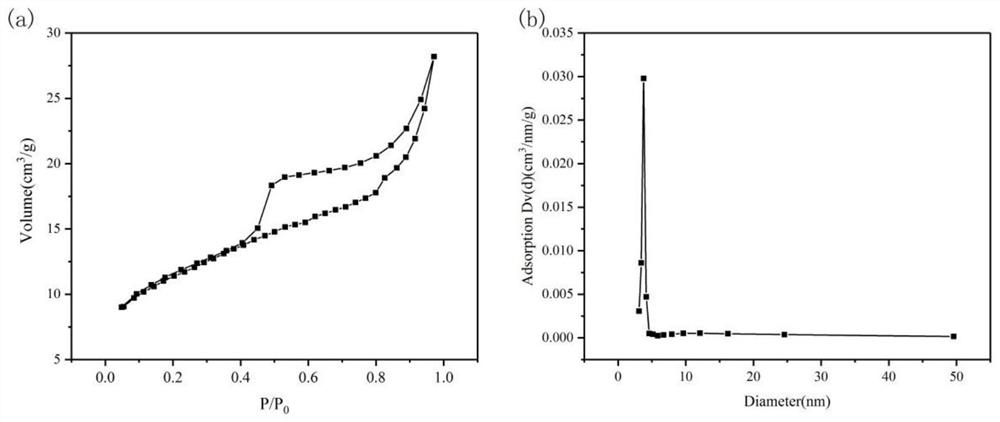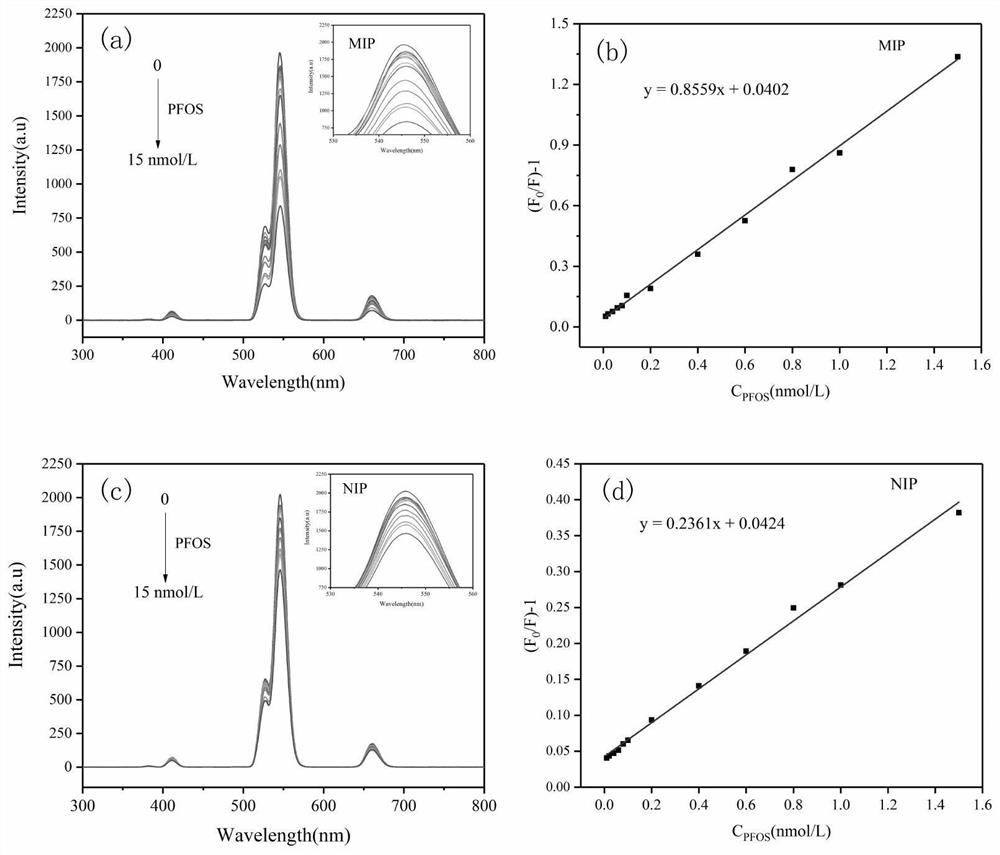Preparation and application of perfluorooctane sulfonic acid mesoporous molecularly imprinted fluorescent probe based on up-conversion material
A perfluorooctane sulfonate mesoporous and molecularly imprinted technology, applied in the field of molecularly imprinted fluorescent probes, can solve the problems of complicated instrument operation, limited application and popularization, expensive instruments, etc., achieve good selectivity, improve detection efficiency, reduce The effect of testing costs
- Summary
- Abstract
- Description
- Claims
- Application Information
AI Technical Summary
Problems solved by technology
Method used
Image
Examples
Embodiment 1
[0035] Preparation of PFOS mesoporous molecularly imprinted fluorescent probes for upconversion materials:
[0036] (1) Up-conversion material NaYF 4 : Yb, the preparation of Er: will contain the LnCl of 1mmol 3 (Ln=Y:Yb:Er, 80:18:2) 5mL aqueous solution was added to a 50mL beaker, then 2mmol sodium citrate and 10mL water were added, magnetically stirred for 10min, NaCl (2.88mmol) and NH 4 A 5 mL aqueous solution of F (6 mmol), OA (10 mL), and ethylene glycol (5 mL) were added to the above solution, and after stirring for 30 min, the mixed solution was transferred to a 50 mL reactor and reacted at 180°C for 6 h. After the reaction, use ethanol to centrifuge and wash 3 times, and finally place the obtained solid in a vacuum oven at 60°C for 6 hours to obtain the upconversion material NaYF 4 : Yb,Er(UCNPs).
[0037] (2) Preparation of amino-modified UCNPs: Weigh 100 mg of UCNPs into a 100 mL round bottom flask, add 10 mL of cyclohexane and 1 mL of IGEPALCO-520, and stir vigor...
Embodiment 2
[0040] Applications of PFOS mesoporous molecularly imprinted fluorescent probes for upconversion materials:
[0041]Add 800 μL molecularly imprinted fluorescent probe dispersion solution (0.05 g / L) and a certain volume of BR buffer solution in sequence into a 10 mL stoppered colorimetric tube, mix well, add a certain concentration of PFOS standard solution, and then use deionized water to set Make up to 10mL, react at room temperature for 10min, transfer to a cuvette after the reaction is complete, use a 980nm laser to excite, record the fluorescence emission spectrum and intensity of the system at 545nm, and realize the detection of PFOS according to the change value of the fluorescence intensity at 545nm Quantitative detection; PFOS combined with non-imprinted fluorescent probe experiments were carried out simultaneously under the same conditions.
Embodiment 3
[0043] Characterization of the PFOS mesoporous molecularly imprinted fluorescent probe of the up-conversion material synthesized above:
[0044] (1) figure 1 N of MIP respectively 2 Adsorption-desorption isotherm curve (a) and pore size distribution diagram (b), according to the type of adsorption-desorption curve, the pore characteristics of the sample can be judged. figure 1 (a) It can be seen that N 2 The adsorption-desorption isotherm curve is a typical Langmuir type IV curve, when P / P 0 When greater than 0.4, a wider hysteresis loop appears, indicating that the MIP surface channels have narrower orifices. In addition, the specific surface area of MIP is 38.123m 2 / g, the pore volume is 0.033cm 3 / g. Depend on figure 1 (b) It can be seen that the pore size distribution of MIP is broad and mainly concentrated in the range of 2-50 nm, and the average pore size of mesopores is 3.786 nm. The large specific surface area and moderate pore size of MIP improve the delive...
PUM
| Property | Measurement | Unit |
|---|---|---|
| Average pore size | aaaaa | aaaaa |
Abstract
Description
Claims
Application Information
 Login to View More
Login to View More - Generate Ideas
- Intellectual Property
- Life Sciences
- Materials
- Tech Scout
- Unparalleled Data Quality
- Higher Quality Content
- 60% Fewer Hallucinations
Browse by: Latest US Patents, China's latest patents, Technical Efficacy Thesaurus, Application Domain, Technology Topic, Popular Technical Reports.
© 2025 PatSnap. All rights reserved.Legal|Privacy policy|Modern Slavery Act Transparency Statement|Sitemap|About US| Contact US: help@patsnap.com



